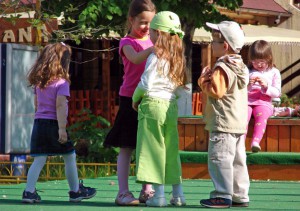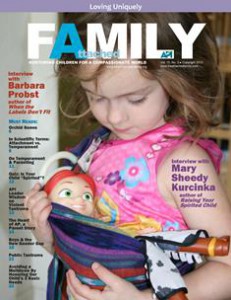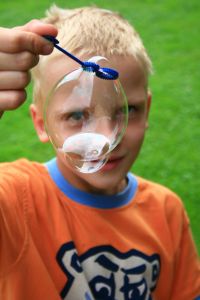 A child’s ability to form healthy self-validation is a vital goal of child development. In fact, a child’s capacity for self-validation has everything to do with the development of emotional safety — the overarching developmental goal of childhood.
A child’s ability to form healthy self-validation is a vital goal of child development. In fact, a child’s capacity for self-validation has everything to do with the development of emotional safety — the overarching developmental goal of childhood.
To use the word “validate” in the context of relationships, we’re referring to the process by which a person values that which she (or he) knows and feels is true and right for herself, and then acts in accordance with her inner knowing in support of her own self and her own needs.
As we raise our children to be intimate with what they feel, sense and know, and to honor and support themselves in their knowing, we are providing them with this fundamentally valuable tool for successfully navigating their internal and external experiences throughout their life.
This is the foundation for a child’s capacity to acquire the more complex self-regulation skills he (or she) needs to actualize his potential. It’s the very important task we have of validating his unconditional goodness, and what he feels, thinks, desires and knows — which then tells him he is “right” in the world, that his experiences are important and that his dreams are valuable.
It’s we — the parents — who largely determine how a child comes to validate him- or herself. Let’s keep this in mind as I describe “Sarah.”
Sarah is 4 years old, joyful, full of life and wicked smart. I was called in to observe her and consult with her preschool teachers and parents due to her “impulsive, inattentive, non-compliant, emotional, potentially dangerous” behaviors of refusing to sit in circle time and constantly banging into objects: outside with her tricycle, and inside where she would run into and purposefully, though playfully, try to topple both other children and adults. Sarah could also be irritable and angry, displaying explosive behaviors when caregivers attempted to redirect her and minimize her complaints.
Sarah had a typical complaint of wanting to do what she wanted to do when she wanted to do it. She argued that she could in fact listen while doing other things during circle time; however, the teachers wanted all the kids sitting “criss-cross apple sauce” on the floor, eyes on them. Because of her complaints, fidgeting and refusal to cooperate, Sarah was made to sit in a chair at a table removed from the group, and to color while the rest of the class conducted their weather discussions, reviewed the alphabet and learned the letter of the day.
Although this decision to exclude Sarah from circle time appears to wrongly shame her, one of her teachers demonstrated both compassion and insight to see that this form of physical structure — sitting on the chair at the table — with an activity to calm her mind and busy her hands — coloring — in fact enabled Sarah to participate fully in their discussions and add to it with more intelligent, creative contributions than most of the other students.
It took some prompting in this rigid classroom, but the staff learned to tweak their expectations and appropriately loosen their requirements of the children, who were then given the choice to sit for circle time or not. Sarah was no longer shamed for being different, and she experienced validation from her teachers that her way of participating in circle time was best for her.
Her teachers’ validation of her translated into her own self-validation for speaking up about what she knew to be true for herself.
In the play yard, we reviewed Sarah’s sensory needs that were mistakenly seen as aggressive in intention. The plowing into objects and people instead suggested she was seeking physical gross-motor input in that she displayed no anger at these times but seemed to have a lot of fun doing the plowing. It served her.
In addition to creating safe places for Sarah to get this physical input — like jumping onto heavy mats from a not-too-high step during scheduled and play intervals throughout the day — we got her mom’s written permission for teachers to give Sarah frequent, deep-pressure hugs and squeezes as a preventative measure to the more impulsive plowing behaviors. I also made a referral for a physical therapy consult. We asked Sarah to let us know when she was feeling out of sorts and to seek the big, bear hugs that immediately calmed her, as soon as her body began to tell her that she needed them.
Her caregivers at school and home began listening to her more — and began seeing her more clearly as a child who needed their support to speak up about her experiences and needs.
I also recommended a nutritional consult, and as a treatment team, we began incorporating the foods into her diet — and eliminating others — that would prove to seem to balance her nervous system so that some of the impulsivity diminished.
Additionally, we built in the time, place and space for her to enjoy more creative, stimulating activities to express herself, learn and teach us about herself: how she thinks, feels, senses and relates to herself, others and the world.
What worked for Sarah is that we were able to see her through various lenses of her holistic health and well-being. By using protocols within the sensory, biology-physical expression, creative self-expression, nutrition and attachment-relationship lenses, we successfully learned to honor what Sarah knew to be true for herself, and we provided her with more knowledge and supports that she needed to further know and support herself.
Sarah learned how to validate herself by internalizing 2 concepts:
- “I am someone who needs, seeks and gets big hugs and squeezes, special play activities and the best foods to make me feel calm, balanced and safe.” She knows that these are the right things for her. And because Sarah taught her caregivers that they need to listen to her and to fully see her and learn from her, Sarah was able to internalize an aspect of her identity as a person of value in the world.
- “I am valued. What I think, feel, want, experience and express matters to others. I am worthy of being heard and seen and respected.” She needed us to validate her so that she could further validate her own self and know that she is doing the right things to keep herself in balance and feel safe.
You can substitute just about any example of a child’s life situation here. The experiences and lessons will likely be the same: We want our child to know what it is that she (or he) knows, to honor what it is that she knows and, when old enough, to seek the supporting knowledge to inform her decisions further.
The thing is, we need to really see our child and listen to him (or her). We cannot try to make him fit into an old ideal of how he “should” behave, act or be. We must meet him “where he’s at” and start there. Our goal is that we use and teach skills sets containing “ways of thinking and doing” to support children in being themselves throughout the trajectory of their lives.
Children can and do fall through the cracks. If we had continued to ignore what Sarah was telling us, she may likely have developed increased shame, anger, rebellion and, over time, an attitude of “Forget you, you’re not listening to me. I’ll do what I want and feel good about it.”
She might have someday came to validate herself in other ways that create rage, division and resentment. She very well could have tied in with peers who not only validate these emotions but — worse — use them to fuel deeper discord, judgment, intolerance, hatred, retaliation and violence.
To some, Sarah’s classroom experiences may seem small. It may seem like the negative outcomes I postulated are a stretch to what actually happened in the classroom. I am telling you, this is so not a stretch. This is how it begins: We do not see our children, so we do not listen to our children and then we try to put them under our thumb. This is not holistic child care. This is not the way we promote secure attachment at home or at school.
In another scenario, Sarah may have other tendencies. Perhaps instead, she withdraws — becoming depressed and later numbing out with drugs, food and dysfunctional relationships. Are those fates any less happy for her? With another who validates her anger and aggression, at least she feels like she’s accepted and belongs somewhere. In all cases, she’s only simply seeking to keep herself safe.
Feeling balanced on the inside by people and circumstances who support her and provide balance “on the outside” do this. We do this. Our child’s emotional safety, her (or his) happiness and her success depend on us. The level of peace in the world depends on us.
I’ve seen the outcomes of ignoring kids’ true needs before, and so have you — in the variations of the same tragic stories that we hear about in the media so often we are becoming numb to them. Do you see that this is an epidemic?
Do you see that we can stop violence, and all that goes with it, in our children if we pay more attention to how we see them and relate to them? It is a simple concept — though a complex process that requires work and perhaps new paradigms for teaching teachers, supporting parents and addressing mental health.
We’ve got to fully wake up and act on how this dynamic works for the sake of helping our children grow up happily, confidently and peacefully. We have no one to blame if we do not target this now.
Editor’s note: Photo source
 Many families discover Attachment Parenting in their quest for how to raise their “spirited” children.
Many families discover Attachment Parenting in their quest for how to raise their “spirited” children.






